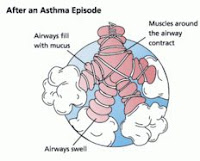High rates of persistent and uncontrolled asthma in US: 50% of patients don't use controller medications
 The CHOICE survey included 1,000 patients with asthma (Comprehensive Survey of Healthcare Professionals and Asthma Patients Offering Insight on Current Treatment Gaps and Emerging Device Options, CHOICE).
The CHOICE survey included 1,000 patients with asthma (Comprehensive Survey of Healthcare Professionals and Asthma Patients Offering Insight on Current Treatment Gaps and Emerging Device Options, CHOICE).How bad is the current situation?
Almost half of the patients (490 out of 1,000) were not using asthma controller medications. Most of those not using controllers (79%) had persistent asthma; 47% had either mild or moderate persistent asthma.
Of patients who were using asthma controllers, only 14% were well controlled.
As expected, acute care utilization was greater for patients with persistent and poorly controlled asthma.
The CHOICE survey demonstrates for the first time the current extent of poor asthma control in the U.S., using the Expert Panel Report III (EPR 3) methods. This situation falls far short of national asthma management targets, and needs urgent improvement.
What can be done to improve asthma control?
A multifaceted approach is required. Here are some suggestions. Web-based interventions, such as educational videos and social networking, and reminders such as text messaging need to be explored in the quest to achieve asthma control targets.
Here is what we use at AllergyCases.org to improve patient understanding and technique of the use of asthma inhalers:
Information For Patients
How to use your asthma inhalers and nebulizer (video)
How to use a spacer (video)
Action plan for asthma and peak flow meter video
Allergy Testing
Asthma & Allergy Medications
Asthma, Allergies and Pregnancy
Asthma Triggers and Management
Childhood Asthma
Cough in Children
Inhaled Asthma Medications
Peak Flow Meter
Asthma Control Test (ACT) - web-based version and PDFs
Dusty The Asthma Goldfish and His Asthma Triggers Coloring Book, by EPA (PDF)
References
The CHOICE survey: high rates of persistent and uncontrolled asthma in the United States. Annals of Allergy, Asthma & Immunology, Volume 108, Issue 3 , Pages 157-162.e1, March 2012.
Image source: Wikipedia, public domain.